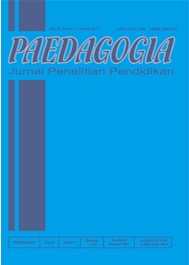Exploring Moral Value in Brianna and Bottomwise for Indonesian High School Teaching Material
Abstract
Keywords
Full Text:
PDFReferences
Aisah, S. (2015). Nilai-Nilai Sosial Yang Terkandung Dalam Cerita Rakyat “Ence Sulaiman” Pada Masyarakat Tomia. Jurnal Humanika, 3(15).
Amna, I. H., & Rasymah. (2022). Analisis Unsur Intrinsik Dalam Novel Te O Toriatte (Genggam Cinta) Karya Akmal Nasery Basral. KANDE: Jurnal Ilmiah Pendidikan Bahasa Dan Sastra Indonesia, 3(2), 227–239.
Anggraini, D., Ariesta, R., & Trianti, A. (2023). Pengembangan Bahan Ajar Sastra Cerita Rakyat Nusantara Berbasis Reader Respons. Diksa : Pendidikan Bahasa Dan Sastra Indonesia, 8(2), 126–136.
Ardiana, Z. (2014). Sudut Pandang Pencerita Dalam Novel Padang Bulan Karya Andrea Hirata. Jurnal Kata (Bahasa, Sastra, Dan Pembelajarannya), 2(1), 1–10.
Astuti, D. ;, Keysha, E. P. F., Esti, A., & Titik, S. (2025). Peran Pendidikan Moral Novel Dilan Dia Adalah Dilanku Tahun 1990 Karya Pidi Baiq dalam Pembentukan Karakter Remaja. Kopula: Jurnal Bahasa, Sastra, Dan Pendidikan, 7(1), 172–179. https://doi.org/10.29303/kopula.v7i1.6272
Atikah, N., Gistituati, N., Fitria, Y., & Syarifuddin, H. (2021). Validitas E-Modul Matematika Sekolah Dasar Berbasis Pendekatan Realistic Mathematics Education (RME). Jurnal Basicedu, 5(6), 6103–6109. https://doi.org/10.31004/basicedu.v5i6.1799
Budiawan, A., Muljani, S., & Anwar, S. (2022). Aspek Kepribadian Tokoh Pada Novel Si Anak Kuat Karya Tere Liye Dan Implikasinya Terhadap Pembelajaran Bahasa Indonesia DI SMA. ALINEA : Jurnal Bahasa, Sastra Dan Pengajarannya, 2(3), 502–515. https://doi.org/10.58218/alinea.v2i3.365
Djojosuroto, K., & Surastina. (2009). Pembelajaran Apresiasi Sastra sebagai Sarana Pengembangan Kreativitas Guru. Pustaka Book Publisher.
Ervina, I. (2019). Nilai Moral Dalam Novel Jilbab Traveler (Love Sparks In Korea) Karya Asma Nadia. UNIVERSITAS NUSANTARA PGRI KEDIRI.
Faozi, R., & Qomariyah, U. (2020). Nilai Moral Pada Antologi Cerpen Kasur Tanah (Cerpen Pilihan Kompas 2017) Dan Kelayakannya Sebagai Bahan Ajar Sastra Di SMA/ MA. Jurnal Pendidikan Bahasa Dan Sastra Indonesia, 9(1), 49–57.
Handayani, C. S., & Sudiatmi, T. (2022). Education of The Character of The Main Characters In The Novel Merasa Pintar , Bodoh Saja Tak Punya By Rusdi Mathari ( Analysis of Literature Psychology ). AKSIS: Jurnal Pendidikan Bahasa Dan Sastra Indonesia, 6(1), 1–10.
Hendrika, M. (2016). Pendidikan Karakter Dalam Novel “Ayah Mengapa Aku Berbeda?” Karya Agnes Davonar (Pendekatan Strukturalisme). Diksa: Pendidikan Dan Sastra Indonesia, 2(1), 54–66.
Kosasih, E. (2012). Dasar Dasar Keterampilan Bersastra. Yrama Widya.
Kosasih, E. (2021). Pengembangan Bahan Ajar. PT Bumi Aksara.
Kurniawan, A. R., Chan, F., Pratama, A. Y., Yanti, M. T., & Fitriani, E. (2019). Analisis Degradasi Moral Sopan Santun Siswa di Sekolah Dasar. Jurnal Pendidikan IPS, 9(2), 104–112.
Lubis, A. A. (2021). Nilai Pendidikan Moral Pada Novel “ Pulang ” Karya Tere Liye : Tinjauan Semiotik Dan Implementasinya Sebagai Bahan Ajar. Prosiding Seminar Nasional PBSI-IV Tahun 2021.
Majid, A. (2008). Perencanaan Pembelajaran. PT Remaja Rosdakarya.
Mangunwijaya, Y. . (1994). Sastra dan Religiositas. Kanisius.
Meriyanti, Syam, C., & Seli, S. (2018). Nilai Moral Dalam Cerita Rakyat Kabupaten Melawi. Jurnal Pendidikan Dan Pembelajaran: Khatulistiwa, 1–9.
Nurgiyantoro, B. (2007). Teori Pengkajian Fiksi. Gadjah Mada University Press.
Pradana, R. P., Sudiatmi, T., & Suparmin. (2021). Pendidikan Karakter Pada Tokoh Utama Dalam Novel Bara Karya Febrialdi Rusdi Sebagai Alternatif Bahan Ajar Di SMK. Prosiding Seminar Nasional Sastra , Lingua , Dan Pembelajarannya ( Salinga ), 130–135.
Prastowo, A. (2012). Panduan Kreatif Membuat Bahan Ajar yang Inovatif. Diva Press.
Prastowo, A. (2015). Menyusun Rencana Pelaksanaan Pembelajaran (RPP) Tematik Terpadu: Implementasi Kurikulum 2013 untuk SD/MI. Prenada Media Group.
Setyoningsih, Y. D. (2018). Tantangan Konselor di era milenial dalam mencegah degradasi moral remaja. Prosiding SNBK (Seminar Nasional Bimbingan Dan Konseling), 2(1), 134–145.
Sjarkawi. (2005). Pembentukan Kepribadian Anak. Bumi Aksara.
Suarta, I. M., & Dwipayana, I. K. A. (2014). Teori Sastra (p. 206). Rajawali Pers.
Sungkono. (2003). Pengembangan Bahan Ajar. FIP UN.
Teeuw, A. (1984). Sastra dan Ilmu Sastra. Pustaka Jaya.
Triana, P. O. (2020). Nilai Moral Novel Si Anak Kuat Karya Tere Liye Dan Implementasinya Sebagai Alternatif Bahan Ajar Di SMA. Prosiding Seminar Literasi V, 1.
Verulitas, E., & Cahyono, A. (2016). Nilai Budaya Dalam Pertunjukan Rapai Geleng Mencerminkan Identitas Budaya Aceh. Catharsis: Journal of Arts Education, 5(1), 41–47.
Yanti, Y., Asrizal, & Festiyed. (2019). Pengertian, Jenis-jenis, dan Karakteristik Bahan Ajar Cetak Meliputi Hand Out, Modul, Buku (Diktat, Buku Ajar, Buku Teks), LKS dan Pamflet. https://doi.org/https://doi.org/10.31227/osf.io/3w7nu
Zakiyah, Q. Y., & Rusdiana. (2014). Pendidikan Nilai: Kajian Teori dan Praktik di Sekolah. Pustaka Setia.
Zulfardi, D. (2020). Wujud Nilai Moral Dalam Novel Amira : Cinta Dari Tanah Surga Karya Suliwe. Jurnal Pendidikan Rokania.
Refbacks
- There are currently no refbacks.








